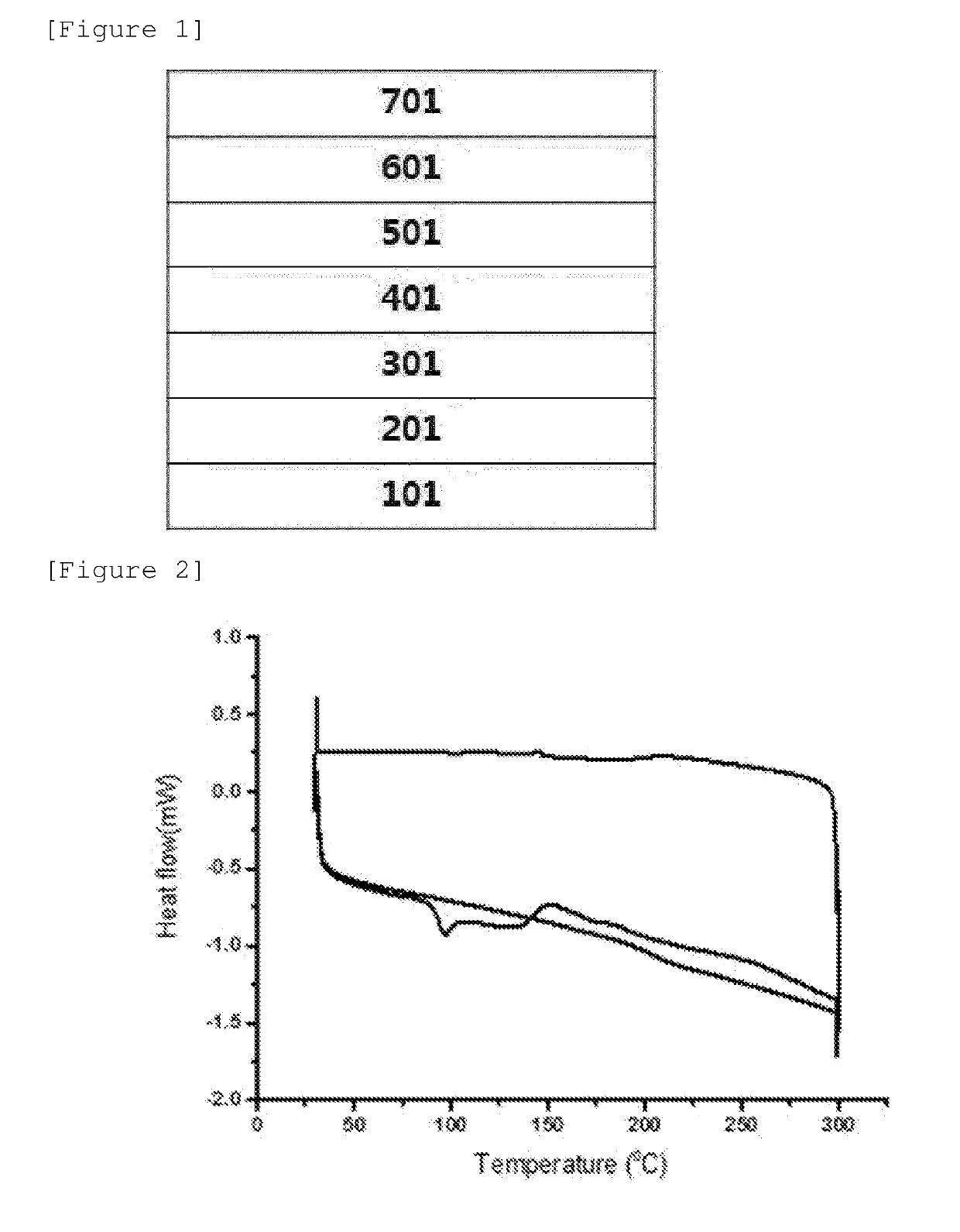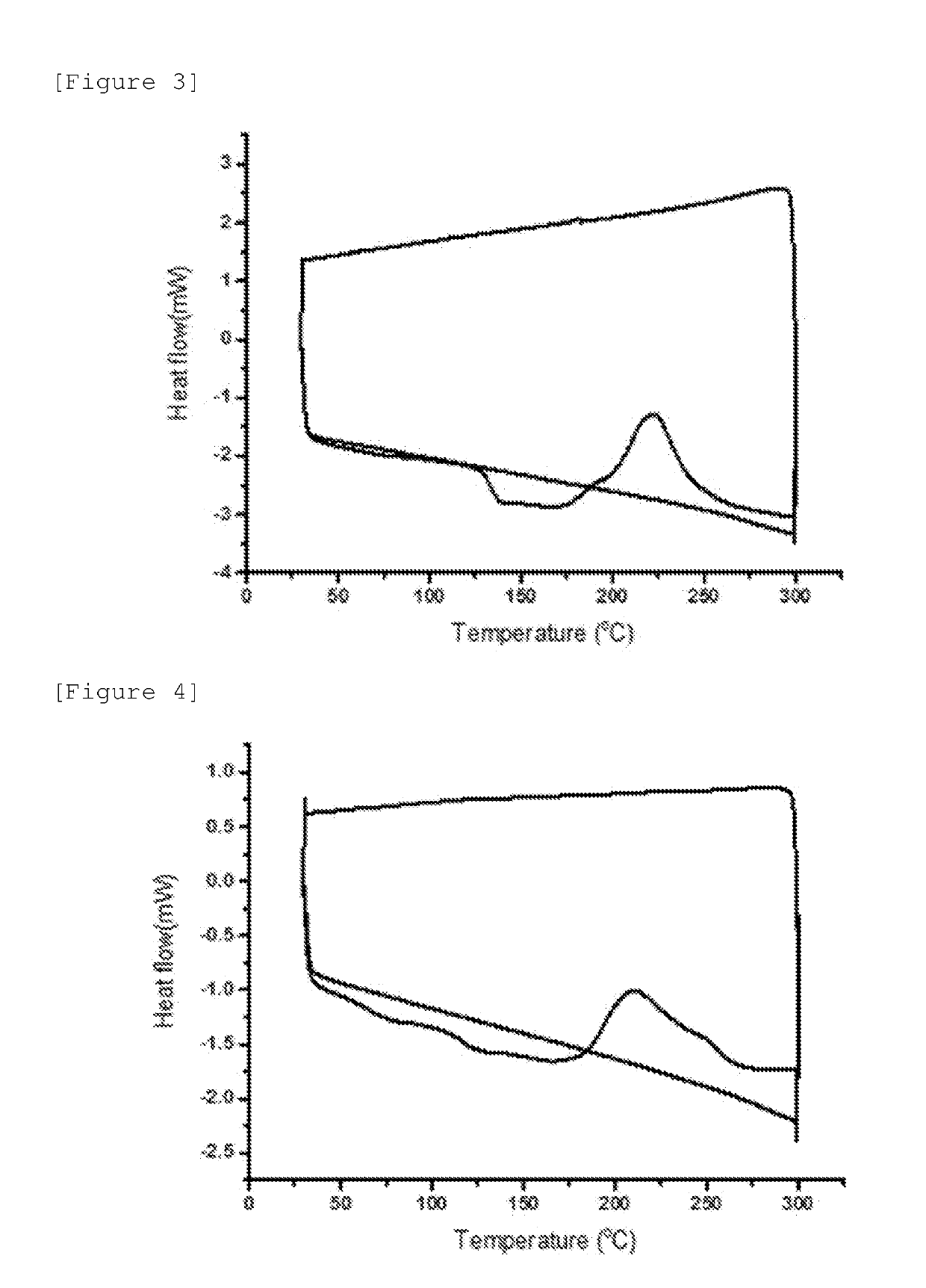Fluorine-based Compound, Organic Light-emitting Device Using Same and Method for Preparing Same
- Summary
- Abstract
- Description
- Claims
- Application Information
AI Technical Summary
Benefits of technology
Problems solved by technology
Method used
Image
Examples
preparation examples
Preparation Example 1. Synthesis of Compound 1
[0257](1) Synthesis of Intermediate 3
[0258]Synthesis of 2-bromo-9-phenyl-9H-fluoren-9-ol (2): A flask containing a solution having 2-bromo-9H-fluoren-9-one (1) (5 g, 19.3 mmol) dissolved in anhydrous tetrahydrofuran (THF) was put into an iced water bath. Phenylmagnesiumbromide (3 M in tetrahydrofuran [THF], 9.65 ml, 29.0 mmol) was added thereto, and the resulting mixture was stirred for 20 minutes at 0° C. The reaction was stopped with NH4Cl (aq), followed by extraction with diethyl ether (Et2O). The organic layer was dried using MgSO4, and the organic solvent was removed using a vacuum rotary evaporator. The residue was column purified to obtain 6.5 g (quantitative yield) of Intermediate 2.
[0259]Synthesis of 2-bromo-9-phenyl-9H-fluorene (3): After Intermediate 2 (3.6 g, 10.6 mmol) was dissolved in dichloromethane [DCM], triethylsilane (2.6 ml, 16.1 mmol) and 1.3 ml of trifluoroacetic acid were added thereto, and the resulting mixture wa...
preparation example 2
10
[0268](1) Synthesis of Intermediate 10
[0269]Synthesis of 1-bromo-4-(6-bromohexyl)benzene (9): After 1,4-dibromobenzene (8) (8.0 g, 33.9 mmol) was dissolved in tetrahydrofuran [THF], the temperature was lowered using a dry ice / acetone bath. nBuLi (13.6 ml, 33.9 mmol, 2.5 M in hexane) was slowly added thereto, and then the resulting mixture was stirred for 1 hour. Next, 1,6-dibromohexane (11 ml, 72 mmol) was added thereto, and then the resulting mixture was stirred overnight. The reaction was stopped with water, and the product was extracted with dichloromethane. The extract was subjected to distillation purification to obtain 5.7 g (yield 53%) of Intermediate 9.
[0270]Synthesis of 1-(6-bromohexyl)-4-vinylbenzene (10): After Intermediate 9 (3.0 g, 9.4 mmol) and vinyl trifluoroborane potassium salt (1.9 g, 14 mmol) were dissolved in tetrahydrofuran [THF], a 2 N aqueous Cs2CO3 solution and Pd(PPh3)4 (1.1 mg, 0.94 mmol) were added thereto, and the resulting mixture was stirred under a r...
preparation example 3
29
[0276](1) Synthesis of Intermediate 12
[0277]Synthesis of 4-(4-bromobutoxy)benzaldehyde (12): 4-hydroxybenzaldehyde (6.1 g, 50 mmol), potassium carbonate (10 g, 75 mmol), and 1,4-dibromobutane (12 ml, 100 mmol) were dissolved in acetone, and then the resulting solution was refluxed for 3 hours. After the reactant was filtered, the organic solvent was removed by using a vacuum rotary evaporator, and the residue was column purified to obtain 7.7 g (yield 60%) of Intermediate 12.
[0278](2) Synthesis of Intermediate 14
[0279]Synthesis of 4-(4-(2-bromo-9-phenyl-9H-fluoren-9-yl)butoxy)benzaldehyde (13): Intermediate 3 (9 g, 28 mmol) and Intermediate 12 (7 g, 27.2 mmol) were dissolved in 60 ml of dimethyl sulfoxide [DMSO] in an oil bath at 50° C. 1.5 ml of 50 wt % NaOH (aq) was added thereto, the resulting mixture was stirred overnight, 1.5 ml of 50 wt % NaOH (aq) was added again thereto, and the resulting mixture was further stirred for 2 hours. The reactant was added to 600 ml of water an...
PUM
| Property | Measurement | Unit |
|---|---|---|
| Temperature | aaaaa | aaaaa |
| Fraction | aaaaa | aaaaa |
| Temperature | aaaaa | aaaaa |
Abstract
Description
Claims
Application Information
 Login to View More
Login to View More - R&D
- Intellectual Property
- Life Sciences
- Materials
- Tech Scout
- Unparalleled Data Quality
- Higher Quality Content
- 60% Fewer Hallucinations
Browse by: Latest US Patents, China's latest patents, Technical Efficacy Thesaurus, Application Domain, Technology Topic, Popular Technical Reports.
© 2025 PatSnap. All rights reserved.Legal|Privacy policy|Modern Slavery Act Transparency Statement|Sitemap|About US| Contact US: help@patsnap.com



